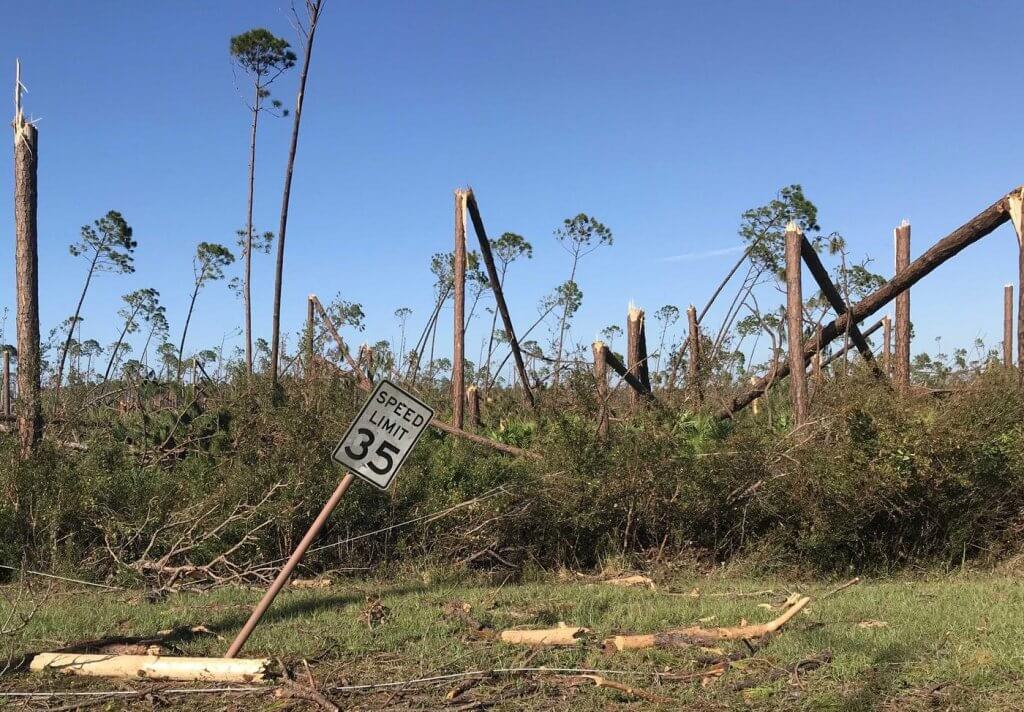Hurricane Michael pummeled southwest Georgia in 2018 and was particularly damaging to the agriculture industry. Dan Chapman/U.S. Fish and Wildlife
Hurricane season is here, and meteorologists say they are expecting an especially active season this year. An outlook by The Weather Company and Atmospheric G2 predicts 12 hurricanes and 25 named storms.
As many of the earth’s oceans have warmed, weather and climate scientists are studying the correlation between climate change and stronger, more destructive hurricanes. Each summer, the warmer water allow these storms to gain strength. With ocean temperatures rising, some assert that hurricanes have more fuel to amp up from a category two or three into a four or five.
A misconception is that global warming creates more hurricanes, but generally, trends show that the same number of storms form each year. The difference scientists are looking into is the increased strength of many hurricanes from recent years.
Pam Knox, extension climatologist at the University of Georgia, says a hurricane on such warm water leads to problems for coastal communities in more ways than one.
“They will intensify more rapidly, and they’re also expected to move more slowly,” Knox said. “If they move more slowly, that means that we’d get more rainfall. It means that we’d have stronger winds for a longer period of time, so that can cause more damage.”
Florida typically takes the brunt of these Atlantic storm systems, or they get pushed up toward the Carolinas. Despite often managing to duck the direct path, Georgia has been battered by several mighty hurricanes in the past few seasons, namely Matthew in 2016, Michael in 2018 and Idalia in 2023.
Hurricane Michael was one of the strongest storms to impact Georgia in the last decade. Photo credit: Georgia Department of Agriculture (2018)
Michael crossed into Georgia as a still-major hurricane and dealt a blow to southwest Georgia and the state’s prized agricultural industry, spurring the governor to convene a special legislative session to fund relief efforts.
Will Lanxton, state meteorologist at Georgia Emergency Management and Homeland Security Agency, or GEMA, has detected an increase in Georgia hurricane damage in the past few years compared to prior decades but partially attributes this change to chance.
“Georgia has been very lucky for the past, honestly, for a very long time,” said Lanxton. “Between 1980, I think 1985, we had Hurricane Kate move through, but after that, the next time we saw hurricane-force impacts in Georgia was in 2016. So we went almost 30 years with no hurricane-force impacts in the state of Georgia.”
A number of factors will play a role in this year’s season. Although warmer ocean temperatures are seen as significant, one other key component is that the coming months are expected to transition from what meteorologists call El Niño conditions into La Niña. The World Meteorologist Association predicts a 60% chance that La Niña conditions emerge sometime around July to September this year.
“When we have a La Niña set up, we tend to see more hurricanes in the Atlantic basin throughout the hurricane season because La Niña decreases the amount of wind shear in the Atlantic basin, and hurricanes hate wind shear,” Lanxton said. “So when there’s less of it, it allows the hurricanes to develop easier and strengthen easier.”
These stronger storms have been able to travel farther inland, causing increased destruction and damage to coastal states like Georgia.
With an intense season likely looming over the southeast, the state’s largest electric utility is preparing to respond to any storm damage and power outages.
Georgia Power Capital Governance and Support Manager Tom Perkins emphasizes the importance of maintaining preparedness throughout the off-season, saying the utility can respond more quickly to a storm when they don’t have to take time to get resources ready.
However, a part of staying ready is assessing how each hurricane season is expected to affect Georgia. Perkins said Georgia Power is currently refreshing its plans and getting fully prepared for the coming months.
“Every distribution area in Georgia Power Company is going over their respective plans to make sure that the assignments are clear, that we’ve got good backups in place as far as the roles and responsibilities and logistics and making sure we’re ready to go,” Perkins said.
In recent years, Georgia Power has worked to increase its efficiency and response capabilities, a necessary adaptation to the trend of stronger hurricane seasons. Plus, people increasingly rely on their power and more so their internet access, meaning that stakes are higher than ever when power is out.
Georgia Power’s Storm Center is the hub that deploys services across the state during a destructive weather event. Kate Verity/Georgia Recorder
“We have seen that customers expect faster service now,” said Fletcher James, distribution construction manager at Georgia Power. “We’ve seen since COVID, a lot of folks work from home and do a lot of their things from home, so that expectation has increased over the years.”
Though Georgia may have dodged major hurricanes in the past decades, there has been a noticeable uptick nationally in the financial toll of hurricanes. According to Lanxton, 18 of the 20 costliest hurricanes across the United States have hit in the last two decades, although he notes that some of this data has not been adjusted for inflation.
Increased cost is often due to increased damages, and increased damages are the results of more category four and five systems wreaking havoc on coastal states. But much like adjusting for inflation, Lanxton said there is bound to be more damage over time if there is more to break: larger cities, increased coastal populations and expanded infrastructure will mean more damage can be sustained than before.
SUPPORT NEWS YOU TRUST.
The post Experts forecast active hurricane season as warming oceans crank up storm intensity appeared first on Georgia Recorder.

